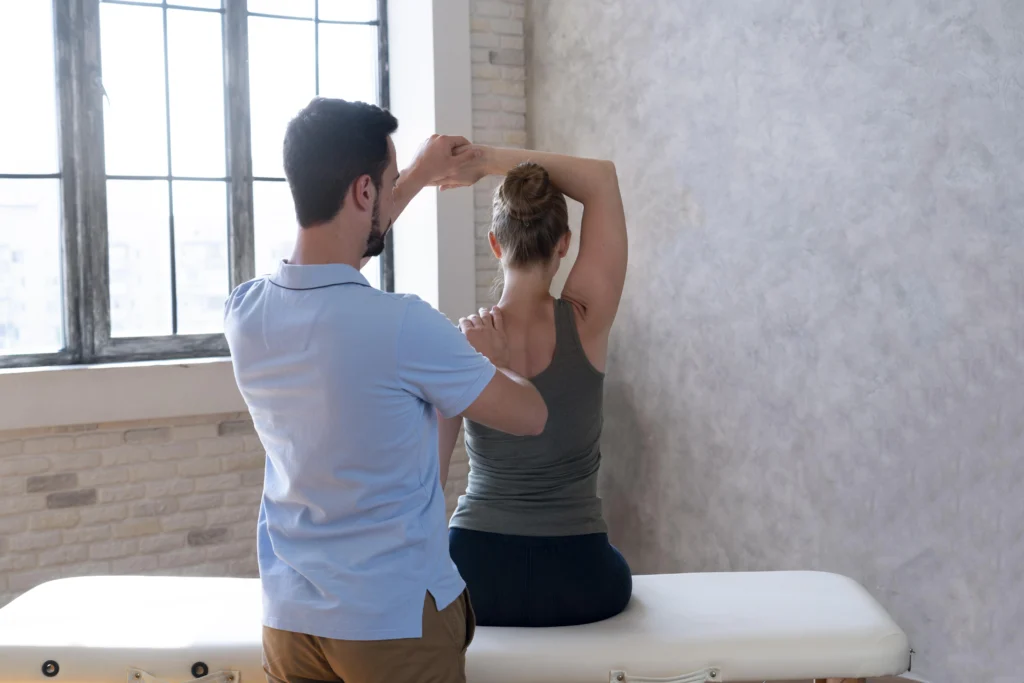Introduction: Back Pain – The Modern Lifestyle Problem
Back pain has become one of the most common health concerns worldwide, affecting millions of people of all ages. In Dubai, where long hours of desk jobs, sedentary lifestyles, and stressful routines are common, back pain is a leading reason people visit physiotherapy clinics.
Physiotherapy offers a non-surgical, drug-free, and long-term solution for back pain by targeting the root cause rather than just masking the symptoms. Whether you suffer from lower back pain, slipped disc, sciatica, or posture-related pain, physiotherapy can help restore mobility, reduce discomfort, and prevent future issues.
1. Common Causes of Back Pain
Understanding the cause is the first step in choosing the right treatment. Common reasons include:
- Poor posture from sitting long hours at a desk or computer
- Muscle strain from lifting heavy objects or sudden movement
- Herniated disc (slipped disc) putting pressure on nerves
- Sciatica causing sharp pain radiating down the legs
- Spinal issues such as arthritis, spondylosis, or scoliosis
- Weak core muscles that fail to support the spine
- Injury or accident leading to back trauma
2. How Physiotherapy Helps in Back Pain Relief
Physiotherapy doesn’t just relieve pain — it addresses the root cause and prevents recurrence.
Pain Relief Techniques
- Manual therapy (hands-on mobilization of joints and soft tissues)
- Electrotherapy (ultrasound, TENS, interferential therapy)
- Dry needling or acupuncture for muscle tightness
Strengthening & Mobility
- Targeted exercises to strengthen the core and back muscles
- Stretching routines to improve flexibility
- Postural correction to reduce spinal stress
Long-Term Recovery
- Ergonomic training for workplace and daily life
- Home exercise plans tailored to your condition
- Education on proper body mechanics and lifestyle changes
3. Types of Back Pain Treated by Physiotherapy
- Lower Back Pain – The most common type, often caused by poor posture, weak muscles, or disc problems.
- Upper Back Pain – Usually linked to poor ergonomics, computer use, or muscle tightness in the shoulders and spine.
- Sciatica – Sharp, radiating pain down the legs due to pressure on the sciatic nerve. Physiotherapy relieves nerve compression and restores mobility.
- Post-Surgical Back Pain – Patients recovering from spinal surgery often require physiotherapy to regain mobility and avoid stiffness.
- Chronic Back Pain – For pain lasting more than 12 weeks, physiotherapy offers long-term management strategies.
4. Physiotherapy Treatments for Back Pain in Dubai
- Manual Therapy – Hands-on techniques like spinal mobilization and massage to relieve stiffness.
- Electrotherapy – Using machines like TENS, ultrasound, or laser therapy to reduce pain and inflammation.
- Exercise Therapy – Custom-designed strengthening and stretching routines for long-term results.
- Dry Needling & Acupuncture – Helps release muscle knots and improve blood flow.
- Postural Training – Correcting sitting, standing, and lifting techniques to reduce strain on the spine.
- Rehabilitation Programs – Structured sessions for people recovering from back injuries or surgeries.
5. Physiotherapy vs. Painkillers & Surgery
Many people first rely on painkillers or quick fixes, but these only mask symptoms. Surgery is often unnecessary unless there’s a severe condition.
- Painkillers – Temporary relief, but pain usually returns.
- Surgery – Risky, expensive, and only needed in extreme cases.
- Physiotherapy – Safe, natural, and treats the root cause for long-term results.
6. Home Exercises Recommended by Physiotherapists
Always consult your physiotherapist before trying these:
- Cat-Cow Stretch – Improves flexibility and relieves stiffness
- Pelvic Tilt – Strengthens lower back and abdominal muscles
- Child’s Pose (Yoga Stretch) – Relaxes the spine and improves posture
- Bridging Exercise – Strengthens glutes and lower back
- Knee-to-Chest Stretch – Relieves pressure on the lower back
7. How to Prevent Back Pain with Physiotherapy Tips
- Maintain good posture at work and home
- Use ergonomic chairs and desks
- Take breaks every 30–45 minutes when sitting
- Exercise regularly to strengthen core muscles
- Avoid lifting heavy objects incorrectly
- Keep a healthy body weight to reduce spinal stress
8. Best Physiotherapy Clinics in Dubai for Back Pain
- Movementon Physio – Personalized back pain treatments with expert therapists
- Emirates European Medical Centre
- DISC (Diversified Integrated Sports Clinic)
- Pure European Physiotherapy Center
Call to Action
If you are struggling with back pain in Dubai, don’t wait until it becomes chronic. Physiotherapy at Movementon Physio provides drug-free, personalized, and long-term relief to help you live pain-free.
Book your consultation today: +971 504240151
Visit us: movementonphysio.com
FAQs on Physiotherapy for Back Pain
Q1: How many physiotherapy sessions are needed for back pain?
It depends on the severity. Mild pain may improve in 5–6 sessions, while chronic pain may require ongoing therapy.
Q2: Can physiotherapy cure back pain permanently?
Yes, if the cause is posture, muscle weakness, or lifestyle. For chronic conditions like arthritis, physiotherapy manages symptoms and prevents worsening.
Q3: Is physiotherapy painful?
No. Some techniques may cause mild soreness, but they are safe and effective.
Q4: Can physiotherapy help with slipped disc or sciatica?
Yes, physiotherapy reduces nerve pressure, improves mobility, and helps avoid surgery in many cases.
Q5: Do I need a doctor’s referral for physiotherapy in Dubai?
No, you can book directly with a licensed physiotherapy clinic.




